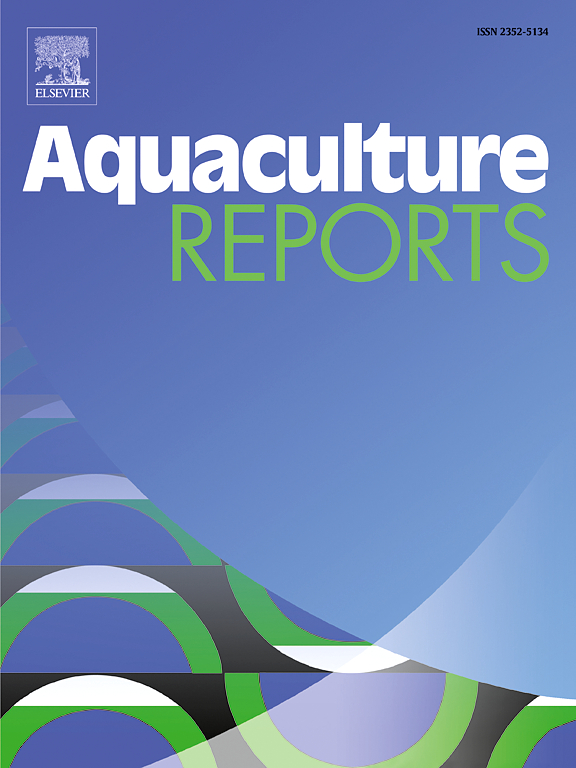芥蓝种子补充对金头鲷生长、健康、免疫、组织病理学和耐热性的影响
IF 3.2
2区 农林科学
Q1 FISHERIES
引用次数: 0
摘要
本试验旨在评价在饲料中添加10、20和40 g/kg剂量的芥蓝籽(Lepidium sativum, GC),饲喂77 d对初始体重= 0.84 ± 0.04 g/鱼的海鲷(Sparus aurata)幼鱼的效果。血液学指标、体成分、饲料消耗、生长性能、肝脏生物标志物和热应激暴露是评估参数。综上所述,饲粮中添加40 g/kg的GC可促进海鲷鱼种的生长和摄食。结果表明,GC对鱼的蛋白质和脂肪含量有有益的影响。此外,研究结果表明,GC显著提高了血液学参数(红细胞压积、血红蛋白、白细胞和红细胞数量)。血清生物标志物值表明,添加40 g/kg水平时,总蛋白、白蛋白、球蛋白、肝脏和肾脏功能增强。此外,在该浓度下,葡萄糖水平同时降低;肝糖原水平升高。结果表明,40 g/kg水平的GC可降低鱼的氧化应激,提高鱼的免疫力,这取决于SOD、MDA和溶菌酶的活性。实验结束时,鱼在4°C和32°C下进行热应激,结果表明,不同浓度的GC作为饲料添加剂处理的鱼表现出比对照组更好的抗性。三脏腑组织病理检查即;在鱼粮中添加GC对肝脏、肾脏和肠道的器官结构有积极影响。本文章由计算机程序翻译,如有差异,请以英文原文为准。
Assessment of garden cress (Lepidium sativum) seeds supplementation on Gilthead seabream (Sparus aurata) growth, general health, immunity, histopathology, and heat stress tolerance
The present study aims to evaluate the effects of feeding dietary garden cress seeds (Lepidium sativum) (GC) at doses of 10, 20, and 40 g/kg diet for 77 days to seabream (Sparus aurata) fingerlings (starting weight = 0.84 ± 0.04 g/fish). Hematological indicators, body composition, feed consumption, growth performance, liver biomarkers, and exposure to heat stress are the assessed parameters. The current findings indicated that seabream fingerlings growth and feed consumption might be enhanced by the dietary GC administration at the level of 40 g/kg diet. The findings showed that GC had a beneficial impact on the fish protein and fat content. Additionally, the findings demonstrated that GC considerably enhanced the hematological parameters (hematocrit, hemoglobin, and the number of white and red blood cells). Serum biomarkers’ values indicated an enhancement in the total protein, albumin, globulin, liver and kidney functions at 40 g/kg supplementation level. Furthermore, at this concentration, the glucose level was depressed meanwhile; the liver glycogen level was increased. Results showed that the use of GC at a level of 40 g/kg decreased the oxidative stress and improved the fish immunity depending on the values of SOD, MDA and lysozyme activities. Fish were subjected to a thermal stress at the end of the experiment at 4 and 32°C, and the results indicated that the fish treated with varying concentrations of GC, as a feed additives showed better resistance than the control group. The histo-pathological examination for three internal organs namely; liver, kidney, and intestine illustrated positive effects on the organs architecture when GC was supplemented in fish diets.
求助全文
通过发布文献求助,成功后即可免费获取论文全文。
去求助
来源期刊

Aquaculture Reports
Agricultural and Biological Sciences-Animal Science and Zoology
CiteScore
5.90
自引率
8.10%
发文量
469
审稿时长
77 days
期刊介绍:
Aquaculture Reports will publish original research papers and reviews documenting outstanding science with a regional context and focus, answering the need for high quality information on novel species, systems and regions in emerging areas of aquaculture research and development, such as integrated multi-trophic aquaculture, urban aquaculture, ornamental, unfed aquaculture, offshore aquaculture and others. Papers having industry research as priority and encompassing product development research or current industry practice are encouraged.
 求助内容:
求助内容: 应助结果提醒方式:
应助结果提醒方式:


